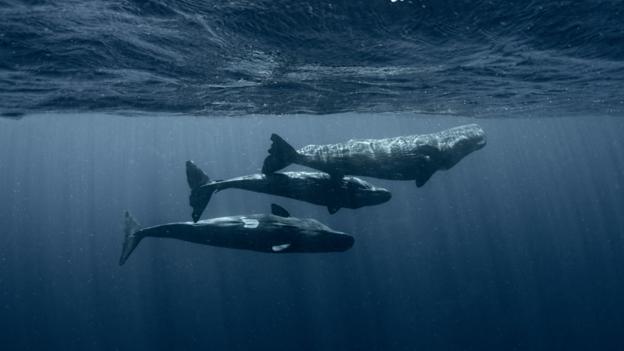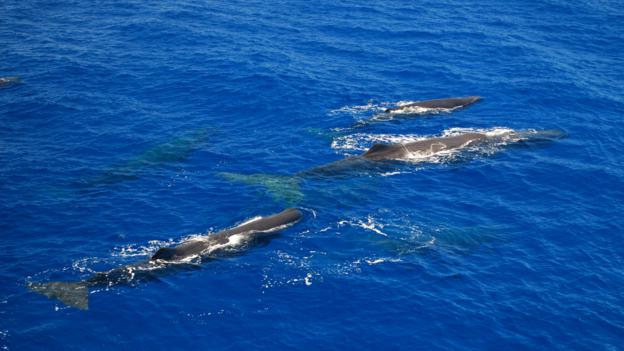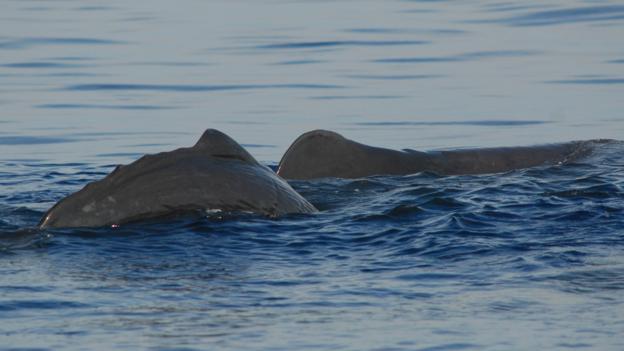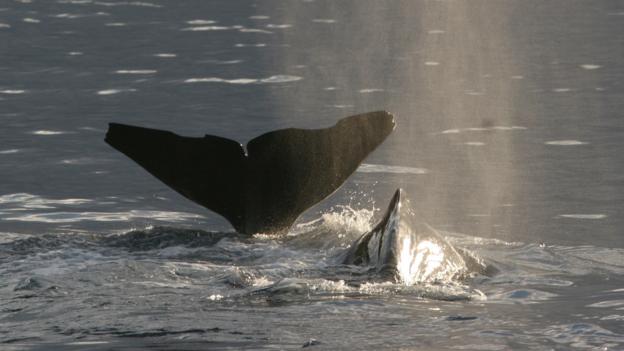Near the Caribbean island of Dominica, there is one group of sperm whales that has interested researchers for over a decade.
Like others in their species, they have complex social lives. But what makes this particular group special is that they live in small family units, allowing researchers to quickly identify individual whales.
The ability to do this has offered us unprecedented insights into their world. For instance, we know that sperm whales remember their friends and family units for many years.
Researchers have now tried to establish exactly how the whales keep track of each other.
In the depths of the murky ocean, recognising a mate by sight alone would be difficult.
Each whale produces short bursts of clicks called "codas". They are so distinct, researchers can identify the whales from sound alone.
"Traditionally we identify sperm whales with pictures of their tails, but once they're chatting it's hard to say who's doing what [using their tails alone]," says lead author Shane Gero of Aarhus University in Denmark. "This one call is variable enough amongst individuals in a family that we can tell them apart."
You can listen to an individual call in the audio clip below.
The whales' language abilities go further. As well as the close-knit families that they live in for their entire lives, they also belong to larger "clans": with specific dialects to match.
The Caribbean clan members do not meet often,
but when they do they use specific codas. You can hear an example of
this in the clip below. All clan members produce these codas in a
specific way, which researchers cannot tell apart.
These clans can consist of several hundred individuals. They all "speak" in the same patterns of clicks even if they live thousands of miles apart.
The results have been published in the Royal Society Open Science journal.
They are the first evidence of the "social complexity hypothesis" in a marine species. The idea here is that if an animal has a complex social world, it has a greater need for diverse ways to communicate.
"I show that whales have all the necessary calls to identify individuals, their social unit (think families), and their cultural clans (think ethnic group)," says Gero.
Whales that make different coda repertoires do not spend any time together.
The team established these unique patterns across nine different families from the Dominican whale clan. They eavesdropped on the whales' clicks over 324 days of observation, spread over six years.
It makes sense that sperm whales communicate in this way, says Gero. They need to be able to differentiate between their family and clan members even when submerged, and we know that they have long-lasting preferences for the individuals they spend most time with.
"We've shown here that they have calls that
could function to mediate all of these different social relationships
that we've known have existed for a while," says Gero.
While the Caribbean clan is small, consisting of a few hundred whales living across about 1,000km (620 miles), the clan in the Pacific Ocean is much larger and lives further apart. There could be over 1,000 individuals. The dialects from one clan can therefore range over several thousand kilometres.
That implies something rather dramatic. If all
the ocean's sperm whales use these vocal markers to define cultural
groups, then they are "the largest cultural and cooperative groups
outside of humans", Gero says.
Now that these individual and clan codas have been established, the researchers hope to play them back to the whales to see how they react. Doing so will tell them more about how language abilities are shared by whales and just how and when certain clicks are used.
For example, the clip below features several whales "talking" at once, but distinct individual calls can still be clearly made out.
The work once again establishes that each sperm whale plays an integral part in its family. Like ours, their complex relationships are based on shared experiences and culture.
The findings push our understanding of the cultural complexity of whales to another level, says Lori Marino, a neuroscientist by training who now advocates animal rights at the Kimmela Center for Animal Advocacy, and was not involved with the study.
Just like us, the whales have cultural cues that exist on many levels, she says: the individual, the social unit and the clan.
"Whereas years ago the question of whether whales and other animals possess cultural traditions was still considered somewhat fanciful, we now know that many other animals, including sperm whales, have very complex traditions.
"Cultural patterns in sperm whales really can be defined as traditions in the true sense of the word."
Like others in their species, they have complex social lives. But what makes this particular group special is that they live in small family units, allowing researchers to quickly identify individual whales.
The ability to do this has offered us unprecedented insights into their world. For instance, we know that sperm whales remember their friends and family units for many years.
Researchers have now tried to establish exactly how the whales keep track of each other.
Calves take over two years to learn to make the coda (click) types accurately (Credit: Amanda Cotton/acottonphoto.com)
This one call is variable enough amongst individuals in a family that we can tell them apartIt has now become apparent that each individual whale makes unique calls. These are similar to two kinds of markers that humans use to identify ourselves: our names and voices.
Each whale produces short bursts of clicks called "codas". They are so distinct, researchers can identify the whales from sound alone.
"Traditionally we identify sperm whales with pictures of their tails, but once they're chatting it's hard to say who's doing what [using their tails alone]," says lead author Shane Gero of Aarhus University in Denmark. "This one call is variable enough amongst individuals in a family that we can tell them apart."
You can listen to an individual call in the audio clip below.
The whales' language abilities go further. As well as the close-knit families that they live in for their entire lives, they also belong to larger "clans": with specific dialects to match.
Male sperm whales can be up to a third larger than adult females (Credit: Marina Milligan/ Dominica Sperm Whale Project)
These clans can consist of several hundred individuals. They all "speak" in the same patterns of clicks even if they live thousands of miles apart.
The results have been published in the Royal Society Open Science journal.
They are the first evidence of the "social complexity hypothesis" in a marine species. The idea here is that if an animal has a complex social world, it has a greater need for diverse ways to communicate.
"I show that whales have all the necessary calls to identify individuals, their social unit (think families), and their cultural clans (think ethnic group)," says Gero.
Whales that make different coda repertoires do not spend any time together.
The team established these unique patterns across nine different families from the Dominican whale clan. They eavesdropped on the whales' clicks over 324 days of observation, spread over six years.
Sperm whales have long-lasting preferences for the individuals they spend most time withThey made acoustic recordings when the whales were both diving and socialising.
It makes sense that sperm whales communicate in this way, says Gero. They need to be able to differentiate between their family and clan members even when submerged, and we know that they have long-lasting preferences for the individuals they spend most time with.
Mothers like this one here, will nurse their calves for several years (Credit: Marina Milligan/Dominica Sperm Whale Project)
They are "the largest cultural and cooperative groups outside of humans""How [else] would you figure out what family member is coming towards you unless you recognise them acoustically?"
While the Caribbean clan is small, consisting of a few hundred whales living across about 1,000km (620 miles), the clan in the Pacific Ocean is much larger and lives further apart. There could be over 1,000 individuals. The dialects from one clan can therefore range over several thousand kilometres.
A sperm whales produce vocalisations using its nose (Credit: Whitehead lab/Dominica Sperm Whale Project)
Now that these individual and clan codas have been established, the researchers hope to play them back to the whales to see how they react. Doing so will tell them more about how language abilities are shared by whales and just how and when certain clicks are used.
For example, the clip below features several whales "talking" at once, but distinct individual calls can still be clearly made out.
The work once again establishes that each sperm whale plays an integral part in its family. Like ours, their complex relationships are based on shared experiences and culture.
The findings push our understanding of the cultural complexity of whales to another level, says Lori Marino, a neuroscientist by training who now advocates animal rights at the Kimmela Center for Animal Advocacy, and was not involved with the study.
Just like us, the whales have cultural cues that exist on many levels, she says: the individual, the social unit and the clan.
"Whereas years ago the question of whether whales and other animals possess cultural traditions was still considered somewhat fanciful, we now know that many other animals, including sperm whales, have very complex traditions.
"Cultural patterns in sperm whales really can be defined as traditions in the true sense of the word."







ไม่มีความคิดเห็น:
แสดงความคิดเห็น